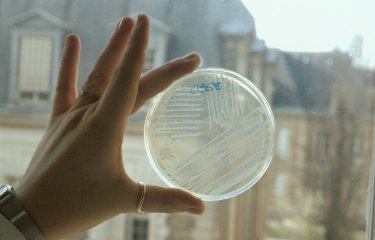In several plasmids of pathogenic bacteria, scientists have identified a sequence that enables bacterial conjugation to take place via a hitchhiking mechanism. This discovery is important as it sheds light on the process and its role in antimicrobial resistance.
Bacteria are prokaryotes, meaning that they are living organisms with no nucleus. As well as the DNA that enables them to live and develop, bacteria also contain small free DNA molecules known as plasmids. Through a process called bacterial conjugation, plasmids are able to be replicated, then transferred from one bacterium to another. It is easy to imagine that this process can allow one bacterium to transfer new capabilities to another. This is the case for the genes coding for antimicrobial resistance, which are often carried and transmitted by plasmids. More than half of known plasmids do not contain the genes required for conjugation, yet they are still able to be transferred by this mechanism. How is this possible?
A specific plasmid sequence enables conjugation
Scientists in the Institut Pasteur's Microbial Evolutionary Genomics Unit, led by Eduardo Rocha, analyzed thousands of bacterial genomes. They demonstrated that most of the plasmids whose transfer mechanism was unknown contain small DNA sequences that do not code for proteins. But these sequences alone enable conjugation via a hitchhiking mechanism, in other words by hijacking the machinery of other plasmids. "These plasmids are hyperparasites – parasites of parasites –, because they hijack the proteins of other plasmids to transfer themselves from one cell to another," explains Eduardo Rocha. Based on the results of this study, it is now possible to predict the transfer mechanisms of 90% of known bacterial plasmids.
Conjugation contributes to antimicrobial resistance
In the pathogenic bacteria Escherichia coli and Staphylococcus aureus, these hyperparasite plasmids contain a large number of genes coding for antimicrobial resistance. A plasmid that confers the ability to resist a hostile environment (like an antibiotic) on its bacterium can replicate and then be transferred to another bacterium by conjugation, and in theory this can continue endlessly. "This ability to adapt easily can transform them into major health threats, as demonstrated by the growing number of deaths associated with multidrug-resistant bacteria worldwide," says Manuel Ares-Arroyo, a scientist in the unit.
Every year, five million people worldwide are thought to die as a result of a bacterial infection.
Source
Manuel Ares-Arroyo, Charles Coluzzi, Eduardo P.C. Rocha, Origins of transfer establish networks of functional dependencies for plasmid transfer by conjugation, Nucleic Acids Research, 2022: gkac1079
This study is part of the priority scientific area Antimicrobial Resistance of the Institut Pasteur's strategic plan for 2019-2023.






